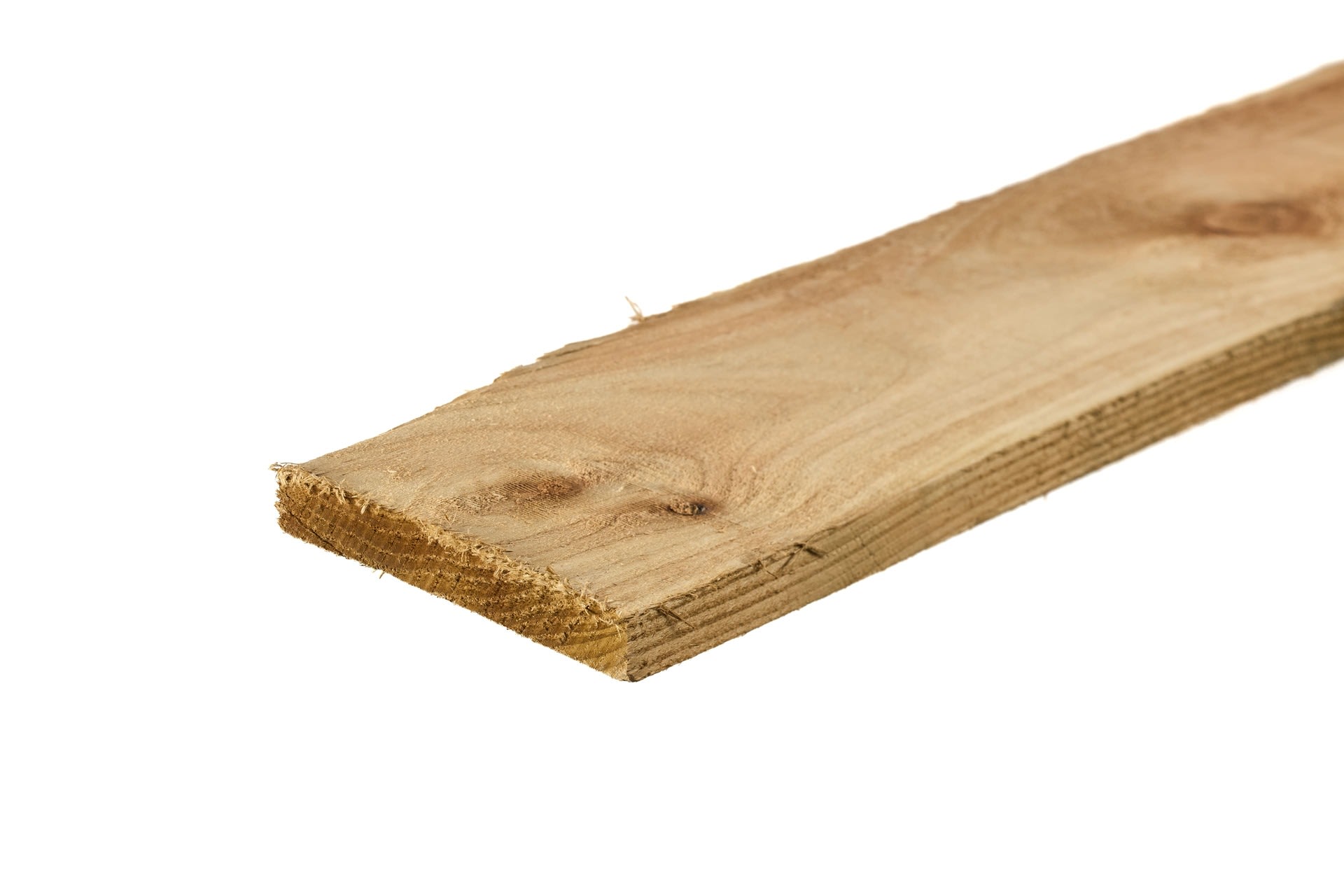6x1 Treated Timber
(10 Products)6x1 treated timber provides a durable, pressure-impregnated softwood section commonly used for cladding, fencing, and general construction applications. Its preservative treatment enhances resistance to decay, moisture, and insect attack, ensuring structural stability and long service life in both interior and exterior environments.
Understanding 6x1 Treated Timber
6x1 treated timber refers to softwood boards nominally measuring 150mm in width and 25mm in thickness before machining.
The timber is typically pressure-treated with copper-based preservatives to provide enhanced protection against rot and fungal decay, allowing for long-term performance in exposed or ground-contact conditions.
This section size is widely used in joinery, construction, and landscaping works, particularly for cladding, fencing rails, decking subframes, and general carcassing.
The treatment process ensures suitability for exterior exposure, while the strength and ease of handling make it an economical and versatile material for site fabrication.
Treated timber of this dimension is available in various finishes - rough-sawn for structural or concealed use, or planed for decorative and precision applications. It is typically produced from sustainably sourced softwoods such as spruce or pine, kiln-dried prior to treatment for dimensional stability and consistent absorption of preservative chemicals.
When correctly specified and installed, 6x1 treated timber provides a robust, adaptable component in domestic, commercial, and civil projects, meeting structural and durability requirements across multiple service classes.
Material Range
- Rough Sawn Treated Timber: Standard structural finish suited for framing, fencing, and subframe work where visual appearance is secondary.
- Planed Treated Timber (PAR): Smooth-surfaced section used in visible or decorative applications such as cladding and joinery.
- UC3 Treated Timber: Treated for external above-ground exposure, ideal for cladding and fencing.
- UC4 Treated Timber: Heavily treated for ground-contact or high-moisture applications, such as posts or sleepers.
Key Features
- Durability: Pressure treatment improves resistance to decay, fungi, and insects.
- Dimensional Stability: Kiln drying minimises movement, shrinkage, and warping.
- Versatility: Suitable for both structural and non-structural purposes.
- Workability: Easily sawn, drilled, and fastened using standard timber tools.
- Sustainability: Typically sourced from FSC® or PEFC-certified forests.
- Weather Resistance: Preservative protection allows long-term external use.
Typical Applications
- Cladding and Facades: Provides weatherproof, treated timber facing for buildings.
- Fencing Rails and Panels: Common size for boundary and agricultural fencing systems.
- Decking Subframes: Used as supporting joists and perimeter framing.
- General Carcassing: Applied in light structural and framing roles.
- Landscaping Structures: Suitable for planters, retaining edges, and external framing.
Specification & Standards
- BS EN 351-1: Defines requirements for preservative treatment of timber.
- BS EN 335: Specifies durability classes and use categories for treated wood.
- BS 8417: Provides guidance on preservation and treatment for defined service life.
- Strength Class: Typically C16 or C24 softwood depending on grading.
- Moisture Content: Kiln-dried to approximately 18–22% prior to treatment.
Related Materials and Construction Uses
6x1 treated timber is frequently used alongside fixings such as galvanised nails, exterior-grade screws, and metal post supports to ensure structural integrity. It complements other timber sections, composite boards, and landscaping materials within exterior frameworks.
When integrated with damp-proof membranes, sealants, or protective coatings, treated timber extends durability and performance across a variety of building applications, from residential decking to agricultural enclosures.
Frequently Asked 6x1 Questions
What Are the Typical Lengths of 6x1 Timber Boards?
Standard lengths for 6x1 timber range from 1.8m to 4.8m, though longer or custom lengths may be available depending on supplier stock and sawn timber specifications.
Which Timber Species Are Commonly Used for 6x1 Boards?
Common species include redwood pine, whitewood spruce, and larch. Each offers different properties for durability, finish, and machining performance depending on the application.
What Use Class Applies to Treated 6x1 Timber?
For exterior above-ground use, treated 6x1 timber should conform to Use Class 3 under BS EN 335 and BS 8417, providing resistance against fungal decay and insect attack in exposed conditions.
Can 6x1 Timber Be Used for Structural Applications?
Generally, 6x1 timber is not graded for structural use unless specified as C16 or C24 structural grade. It is primarily used for non-load-bearing purposes such as cladding or trim.
What Is the Moisture Content of 6x1 Timber?
Kiln-dried 6x1 timber typically has a moisture content between 16% and 20%, suitable for most construction and joinery work. Always condition timber before installation to minimise movement.
Can 6x1 Timber Be Painted or Stained?
Yes, 6x1 timber can be finished with paint, stain, or preservative coatings. Surfaces should be dry, clean, and free of resin before finishing for optimal adhesion and protection.
Is 6x1 Timber Suitable for Outdoor Decking?
6x1 timber is not recommended for decking due to its thickness. Thicker sections such as 6x2 or 4x2 are preferred for deck boards and joists, offering greater load-bearing capacity and durability.
What Fixings Should Be Used With 6x1 Timber?
Use stainless steel or galvanised fixings to prevent corrosion, especially when used externally or with treated timber, ensuring compliance with BS EN ISO 3506 and related standards.


